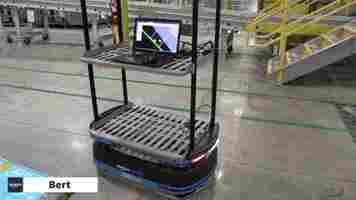New Amazon robots could enable ‘safer’ exploitation of warehouse staff
Weeks after a study revealed that Amazon warehouse workers are injured at higher rates than staff at rival firms, the company has revealed it’s testing new robots designed to improve employee safety.

The e-commerce giant has ingratiatingly named two of the bots after Sesame Street’s Bert and Ernie.
Bert is an Autonomous Mobile Robot (AMR) that’s built to navigate through Amazon facilities. In the future, the company envisions the bot carrying large and heavy items or carts across a site, reducing the strain on its human coworkers.
Ernie, meanwhile, is a workstation system that removes totes from robotic shelves and then deliveries them to employees.
“The innovation with a robot like Ernie is interesting because while it doesn’t make the process go any faster, we’re optimistic, based on our testing, it can make our facilities safer for employees,” said Kevin Keck worldwide director of Advanced Technology at Amazon.
The duo may one day be joined at work by another pair of robot colleagues: Scooter and Kermit, which transport carts across facilities.
Amazon said it plans to deploy Scooter in at least one Amazon facility this year, and introduce Kermit in a minimum of 12 North American sites.
The robots were unveiled amid growing concerns about worker safety at Amazon. Earlier this month, a union-backed report on safety data found serious injury rates at the company were almost 80% higher than the rest of the industry.
Amazon has previously been accused of deceiving the public about the rising injury rates in its warehouses. But in recent months, the company has begun to publicly acknowledge the problem.
In April, Jeff Bezos revealed another system designed to improve worker safety: an algorithm that rotates staff around tasks that use different body parts.
These initiatives are unlikely to discourage accusations that Amazon treats workers like robots. But hopefully, the systems can provide some support for their overworked human colleagues — and don’t end up replacing them.
Greetings Humanoids! Did you know we have a newsletter all about AI? You can subscribe to it right here .
Google’s ‘time crystals’ could be the greatest scientific achievement of our lifetimes
Eureka! A research team featuring dozens of scientists working in partnership with Google‘s quantum computing labs may have created the world’s first time crystal inside a quantum computer.

This is the kind of news that makes me want to jump up and do a happy dance.
These scientists may have produced an entirely new phase of matter. I’m going to do my best to explain what that means and why I personally believe this is the most important scientific breakthrough in our lifetimes.
However, for the sake of clarity, there’s two points I need to make first:
What’s a time crystal?
In colloquial terms, it’s a big screw you to Sir Isaac Newton.
Time crystals are a new phase of matter. For the sake of simplicity, let’s imagine a cube of ice.
When you put a cube of ice in glass of water, you’re introducing two separate entities (the ice cube and the liquid water) to each other at two different temperatures.
Everyone knows that the water will get colder (that’s why we put the ice in there) and, over time, the ice will get warmer and turn into water. Eventually you’ll just have a glass of room-temperature water.
We call this process “ thermal equilibrium .”
Most people are familiar with Newton’s first law of motion , it’s the one that says “an object at rest tends to stay at rest and an object in motion tends to stay in motion.”
An important side-effect of this law of physics is that it means a perpetual motion machine is classically impossible.
According to classical physics, the universe is always moving towards entropy . In other words: if we isolate an ice cube and a room-temperature glass of water from all other external forces, the water will always melt the ice cube.
The entropy (the movement towards change) of any system will always remain the same if there are no processes, and it will always increase if there are processes.
Since our universe has stars exploding, black holes sucking, and people lighting things on fire – chemical processes – entropy is always increasing.
Except when it comes to time crystals. Time crystals don’t give a damn what Newton or anyone else thinks. They’re lawbreakers and heart takers. They can, theoretically, maintain entropy even when they’re used in a process.
What’s that mean
Think about a crystal you’re familiar with, such as a snowflake. Snowflakes aren’t just beautiful because each one is unique, they’re also fascinating formations that nearly break the laws of physics themselves.
Crystalline structures form in the physical world because, for whatever fundamental scientific reason, the atoms within them “want” to exist in certain exact points.
“Want” is a really weird word to use when we’re talking about atoms – I’m certainly not implying they’re sentient – but it’s hard to describe the tendency toward crystalline structures in abstracts such as “why.”
A time crystal is a new phase of matter that, simplified, would be like having a snowflake that constantly cycled back and forth between two different configurations. It’s a seven-pointed lattice one moment and a ten-pointed lattice the next, or whatever.
What’s amazing about time crystals is that when they cycle back and forth between two different configurations, they don’t lose or use any energy.
Time crystals can survive energy processes without falling victim to entropy. The reason they’re called time crystals is because they can have their cake and eat it too.
They can be in a state of having eaten the whole cake , and then cycle right back to a state of still having the cake – and they can, theoretically, do this forever and ever.
Most importantly, they can do this inside of an isolated system. That means they can consume the cake and then magically make it reappear over and over again forever, without using any fuel or energy.
Who cares? What’s this going to mean for me?
Literally everyone should care. As I wrote back in 2018, time crystals could be the miracle quantum computing needs .
Nearly every far-future tech humans can imagine, from teleportation to warp drives and from artificial food synthesizers to perpetual motion reactors capable of powering the world without burning fuels or harnessing energy, will require quantum computing systems.
Quantum computers can solve really hard problems. Unfortunately, they’re brittle. It’s hard to build them, hard to maintain them, hard to get them to do anything, and even harder to interpret the results they give. This is because of something called “decoherence,” which works a lot like entropy.
Computer bits in the quantum world, qubits, share a funky feature of quantum mechanics that makes them act differently when observed than when they’re left alone. That sort of makes any direct measurements of qubit states (reading the computer’s output) difficult.
But time crystals want to be coherent. So putting them inside a quantum computer, and using them to conduct computer processes could potentially serve an incredibly important function: ensuring quantum coherence.
[Greetings Humanoids! Did you know we have a newsletter all about AI and quantum computing? You can subscribe to it right here ]
So Google solved quantum computing?
No. No, no, no, no no. Don’t get me wrong. This is baby steps. This is infancy research. This is Antony van Leeuwenhoek becoming the first person to use a microscope to look at a drop of water under magnification.
What Google‘s done, potentially, is prove that humans can manufacture time crystals. In the words of the researchers themselves:
Basically they believe they’ve proven the concept, so now it’s time to see what can be done with it.
Then why is this so exciting?
Time crystals have always been theoretical. And by “always,” I mean: since 2012 when they were first hypothesized.
If Google‘s actually created time-crystals, it could accelerate the timeline for quantum computing breakthroughs from “maybe never” to “maybe within a few decades.”
At the far-fetched, super-optimistic end of things – we could see the creation of a working warp drive in our lifetimes. Imagine taking a trip to Mars or the edge of our solar system, and being back home on Earth in time to catch the evening news.
And, even on the conservative end with more realistic expectations, it’s not hard to imagine quantum computing-based chemical and drug discovery leading to universally-effective cancer treatments.
This could be the big eureka we’ve all been waiting for. I can’t wait to see what happens in peer-review.
If you want to know more, you can read Google’s paper here . The company published a simple explainer in November 2021 here. And if you’re looking for a technical deep-dive into the scientific specifics of what the researchers accomplished in the lab, this piece on Quanta Magazine by Natalie Wolchover is the bee’s knees.
Give YouTube the finger by restoring dislike counts with this plugin
YouTube’s decision to hide dislike counts on videos has sparked anger and derision .

The company said the move will protect creators from harassment and coordinated attacks, but critics fear it will become harder to find useful and trustworthy content.
Some of them have proposed using YouTube comments as an alternative dislike counter, while others are devising technical fixes.
One inventive programmer has attempted to restore the feature in a browser extension .


The plugin currently uses the Google API to generate the dislike count. However, this functionality will be removed from December 13.
“I’ll try to scrape as much data as possible until then,” the extension’s creator said on Reddit . “After that — total dislikes will be estimated using extension users as a sample.”
The alpha version isn’t perfect. It currently only works on videos for which the Youtube API returns a valid dislike count.
The calculations could also be skewed by the userbase, which is unlikely to represent the average YouTube viewer. The developer said they’re exploring ways to mitigate this, such as comparing the downvotes collected through the public of extension users to a cache of real downvotes. The results should also improve as uptake grows.
Despite these shortcomings, I applaud the effort. Hiding dislikes may comfort some creators, but it also quashes dissent and removes a way of spotting scams, crap tutorials, or clickbait.
The plugin could provide a useful service, but its greatest value may be as a potent symbol of protest.
You can ty it out here — but proceed at your own risk. If you want to check out the code, it’s been published on GitHub .